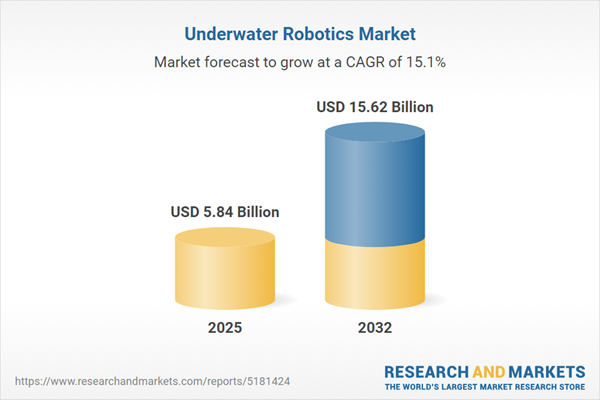Speak directly to the analyst to clarify any post sales queries you may have.
The underwater robotics market is undergoing significant transformation, driven by rapid advances in artificial intelligence, autonomy, and modular technologies. Senior decision-makers across maritime, energy, research, and defense sectors are reevaluating operational strategies in light of shifting regulatory landscapes and emerging supply chain complexities.
Market Snapshot: Underwater Robotics Market Size and Growth Trends
The underwater robotics market grew from USD 5.07 billion in 2024 to USD 5.84 billion in 2025. It is expected to continue expanding at a CAGR of 15.10%, reaching USD 15.62 billion by 2032. These figures underscore robust investment across commercial, defense, and scientific segments, with growth fuelled by demand for advanced autonomy, improved endurance, and AI-driven operational efficiencies.
Scope & Segmentation: Exploring the Underwater Robotics Market
- Vehicle Types: Autonomous Underwater Vehicles (including glider class, buoyancy engine, hybrid class, and torpedo class with electric and hybrid options), Remotely Operated Vehicles (such as micro, observation, and work class), and Unmanned Surface Vehicles (large, medium, and small).
- Applications: Defense & security functions (mine countermeasures, surveillance), inspection & maintenance tasks (including hull and pipeline inspection, underwater welding), research & exploration (marine biology, underwater archaeology), as well as survey & mapping (bathymetric and photogrammetry missions).
- End Users: Defense organizations (coast guard, naval), oil & gas (downstream, midstream, upstream), renewable energy (offshore wind, tidal), and scientific research (academic, government).
- Depth Ranges: Deep water, mid water, and shallow water requirements.
- Propulsion Types: Electric, hybrid, and hydraulic systems for diverse operational profiles.
- Deployment Platforms: Tethered and untethered configurations.
- Components: Imaging systems (multibeam echosounders, optical cameras), manipulators (five axis, two axis), navigation systems (Doppler velocity logs, inertial navigation), and sensors (chemical, pressure, sonar).
- System Integration Types: Modular (hardware only, software only) and turnkey platforms.
- Regional Coverage: Americas (United States, Canada, Mexico; Brazil, Argentina, Chile, Colombia, Peru), Europe, Middle East & Africa (United Kingdom, Germany, France, Russia, Italy, Spain, Netherlands, Sweden, Poland, Switzerland; United Arab Emirates, Saudi Arabia, Qatar, Turkey, Israel; South Africa, Nigeria, Egypt, Kenya), and Asia-Pacific (China, India, Japan, Australia, South Korea, Indonesia, Thailand, Malaysia, Singapore, Taiwan).
- Industry Participants: Teledyne Technologies, Kongsberg Maritime, Oceaneering International, Saab AB, Forum Energy Technologies, Fugro, General Dynamics Mission Systems, ECA Group, Subsea 7, Sonardyne International, among others.
Key Takeaways for Strategic Decision-Makers
- Autonomy and AI adoption are fundamentally reshaping underwater robotics, enabling vehicles to perform complex tasks with greater independence and reliability.
- Collaborative multi-vehicle fleets and modular design architectures expand mission flexibility, operational scale, and rapid system reconfiguration.
- Advanced material science and hybrid propulsion enhance endurance and depth capabilities, broadening the utility of both autonomous and remotely operated platforms.
- New procurement priorities are emerging in response to regulatory changes, infrastructure gaps, and environmental compliance benchmarks, particularly for defense and energy sectors.
- Regional adoption patterns reflect diverse political, economic, and scientific objectives, resulting in differentiated growth strategies for the Americas, EMEA, and Asia-Pacific regions.
- Strategic partnerships and tailored platforms position leading vendors to serve cross-sector needs, from pipeline inspection to marine habitat monitoring.
Tariff Impact and Supply Chain Considerations
Recent United States tariffs on critical underwater robotics components—such as sensors and propulsion modules—have introduced cost challenges and heightened supply chain complexity. Market leaders are expediting localization measures and modular design approaches to mitigate exposure, while end users increasingly seek domestically sourced subsystems and alternative suppliers. These dynamics have sparked innovation in resilient component sourcing and strengthened collaboration between manufacturers, governments, and research institutions.
Methodology & Data Sources
This analysis utilizes a rigorous mixed-methods approach, combining interviews with senior technical leaders and procurement executives, systematic review of peer-reviewed literature, regulatory filings, and white papers, and quantitative modeling of industry trends. Data triangulation ensures reliable market segmentation, validated cost assessments, and robust growth projections.
Why This Report Matters for Senior Leaders
- Offers actionable, segment-specific insights into evolving technology, procurement, and regulatory challenges driving the underwater robotics market.
- Supports informed capital allocation by linking market trends to operational and strategic priorities, including risk management and innovation planning.
- Enables benchmarking of leading vendors and technologies for competitive analysis and partnership evaluation.
Conclusion
The underwater robotics market is set to redefine maritime operations by integrating advanced autonomy, resilient sourcing strategies, and comprehensive lifecycle support. Industry leaders who adapt to these shifts will secure sustained competitive advantage.
Additional Product Information:
- Purchase of this report includes 1 year online access with quarterly updates.
- This report can be updated on request. Please contact our Customer Experience team using the Ask a Question widget on our website.
Table of Contents
3. Executive Summary
4. Market Overview
7. Cumulative Impact of Artificial Intelligence 2025
Companies Mentioned
The companies profiled in this Underwater Robotics market report include:- Teledyne Technologies Incorporated
- Kongsberg Maritime AS
- Oceaneering International, Inc.
- Saab AB
- Forum Energy Technologies, Inc.
- Fugro N.V.
- General Dynamics Mission Systems, Inc.
- ECA GROUP
- Subsea 7 S.A.
- Sonardyne International Limited
Table Information
| Report Attribute | Details |
|---|---|
| No. of Pages | 193 |
| Published | October 2025 |
| Forecast Period | 2025 - 2032 |
| Estimated Market Value ( USD | $ 5.84 Billion |
| Forecasted Market Value ( USD | $ 15.62 Billion |
| Compound Annual Growth Rate | 15.1% |
| Regions Covered | Global |
| No. of Companies Mentioned | 11 |









